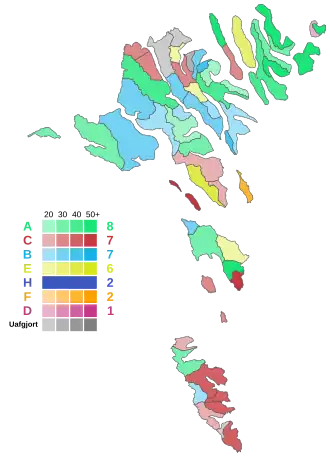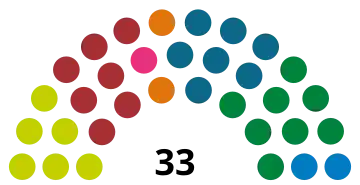2019 Faroese general election|
|
All 33 members in the Løgting
17 seats needed for a majority |
| Turnout | 89.70% |
|---|
|
This lists parties that won seats. See the complete results below.  Map of the election, showing the largest party in each polling area. |
|
General elections were held in the Faroe Islands on 31 August 2019.[1] The elections resulted in the defeat of Aksel V. Johannesen's coalition government consisting of the Social Democrats, Republic, and Progress.[2] Following the elections, a new coalition government was formed by Union Party leader Bárður á Steig Nielsen, consisting of the Union Party, the People's Party and the Centre Party, which won 17 of the 33 seats.[3]
According to political scientist Lise Lyck, the main election issues were public finances (welfare, taxes and public coffers), recent reforms of the fishing sector and same-sex marriage.[2]
Electoral system
The 33 members of the Løgting were elected by open list proportional representation in a single nationwide constituency with an electoral threshold of 1⁄33 of votes (~3.03%).[4] Seats were allocated using the d'Hondt method.[5]
Results
 |
|---|
| Party | Votes | % | Seats | +/– |
|---|
| People's Party | 8,290 | 24.54 | 8 | +2 |
| Social Democratic Party | 7,480 | 22.14 | 7 | –1 |
| Union Party | 6,874 | 20.35 | 7 | +1 |
| Republic | 6,127 | 18.14 | 6 | –1 |
| Centre Party | 1,815 | 5.37 | 2 | 0 |
| Progress | 1,559 | 4.62 | 2 | 0 |
| Self-Government | 1,157 | 3.43 | 1 | –1 |
| Cannabis Initiative | 310 | 0.92 | 0 | New |
| Faroese Party | 167 | 0.49 | 0 | New |
| Total | 33,779 | 100.00 | 33 | 0 |
|
| Valid votes | 33,779 | 99.56 | |
|---|
| Invalid votes | 65 | 0.19 | |
|---|
| Blank votes | 85 | 0.25 | |
|---|
| Total votes | 33,929 | 100.00 | |
|---|
| Registered voters/turnout | 37,827 | 89.70 | |
|---|
| Source: KVF |
References


